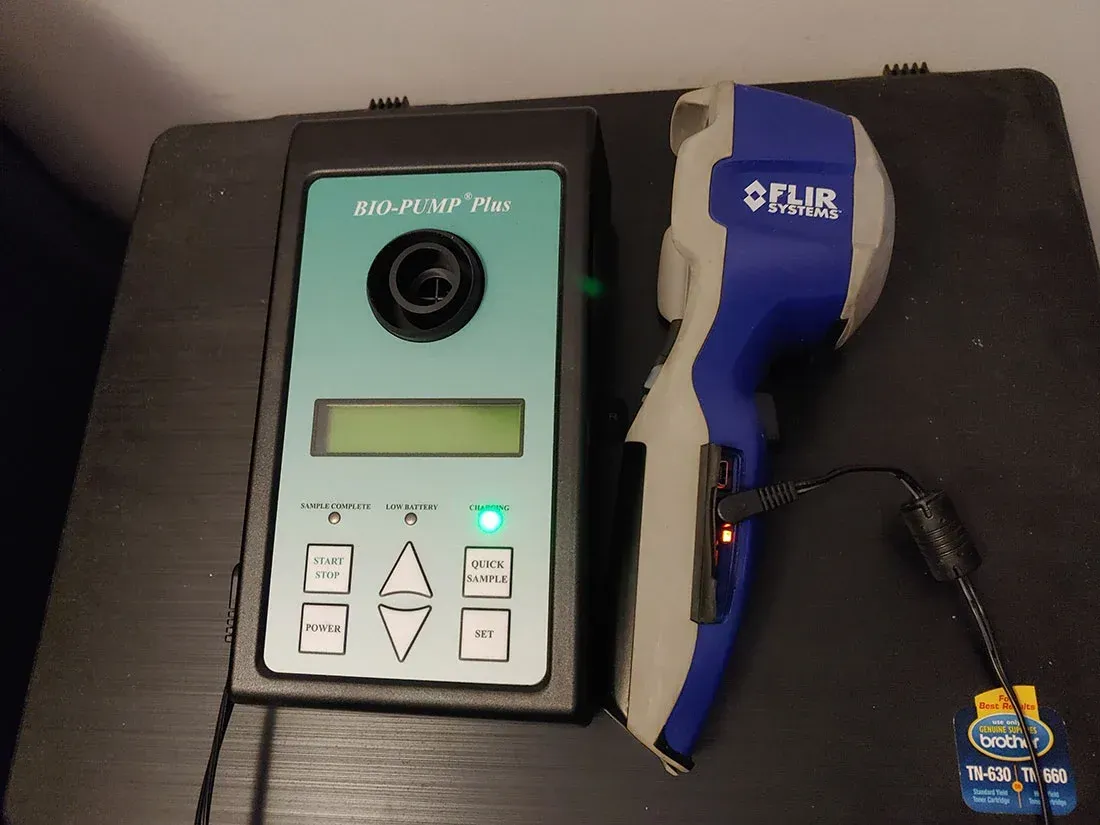Preparing for a Mold Surge: Why Springtime in New Jersey is Prime Season

Spring can be one of the most beautiful times of year in New Jersey. Warmer temperatures coax flowers into bloom, and the landscape becomes vibrant after a long, cold winter. But for many homeowners, the season also brings increased moisture—everything from occasional heavy rains to damp, lingering humidity. Recent scientific work, including a doctoral dissertation from The Ohio State University, highlights how spring is a peak period for mold in indoor spaces. Combined with the challenges of day-to-day life—like cooking, cleaning, or caring for children—this surge in moisture can create a perfect opportunity for mold to spread unnoticed.
This seasonal rise in indoor mold can feel especially urgent for households already coping with allergies or asthma. Yet, even those without respiratory conditions are at risk if mold accumulates behind walls or under floors. Fortunately, recognizing the factors that promote mold growth in spring and taking preventive steps makes it possible to keep your home safer and fresher during the dampest months ahead.
Spring Showers and Thaw: How Moisture Finds Its Way Inside
Springtime moisture doesn’t just appear in random bursts—it arrives with melting snowpack, seasonal storms, and unexpected weather swings that push water toward vulnerable areas of the home. This is when grading issues, roof leaks, and other hidden vulnerabilities come to light. Preventing mold means understanding exactly how water penetrates the structure, especially during these weeks when rains are frequent and the ground is still saturated. By investigating these moisture pathways, homeowners can intercept mold before it finds a foothold indoors.
When spring arrives, melting snowpack and frequent rainstorms often bring extra water into the environment. Many New Jersey homes experience:
· Runoff Near Foundations: Even slight grading issues can direct rainwater or melting snow toward a home’s basement walls or crawl space.
· Clogged Gutters and Downspouts: Leaves and winter debris can back up drainage systems, pushing water over the edges and into siding or roof intersections.
· Small Cracks and Gaps: The freeze-thaw cycle can widen hairline fractures in foundations or around windows, creating new entry points for moisture.
Mold almost always starts with water. Each pathway allows unwanted moisture to slip inside, making spring the perfect time for mold to settle in and grow. By watching for seepage or damp spots soon after storms, you can better cut off mold’s water supply before it creates a colony behind walls or under floors.
Warmer Days, Higher Humidity: A Recipe for Indoor Dampness
Once aware of how water enters from outside, it’s equally important to acknowledge how the shift from chilly winter to mild spring leads to a spike in indoor humidity. This change isn’t strictly about rainfall but also stems from how people adapt their heating and cooling routines. From turning off the furnace prematurely to opening windows at unpredictable times, small daily habits can transform the home into a more humid environment than expected. Recognizing these patterns helps homeowners maintain better airflow and dryness.
It’s not just the rainfall that adds moisture to New Jersey homes. The gradual shift from cold to mild temperatures triggers changes in how homeowners heat, cool, and ventilate their indoor spaces—sometimes with unintended effects. Here’s how spring warmth contributes:
· Switching Off the Heat Too Early: While the furnace often reduces indoor humidity by circulating warm air, turning it off too soon can lead to stagnant, moist air if outside temperatures remain cool at night.
· Inconsistent Ventilation: Windows may be opened during warm afternoons but closed again when temperatures dip after sundown. This can trap indoor humidity from cooking, laundry, and showers.
· Increased Condensation: Warmer air meets cooler surfaces (like basement walls or attic beams), causing condensation to develop where it can’t easily evaporate.
Mold spores thrive in humid environments. Once relative humidity creeps above roughly 60%, porous household materials—drywall, wood framing, and even cardboard boxes—can retain enough moisture to foster mold growth. Spring’s daytime warmth and still-chilly nights make stable ventilation challenging, leaving pockets of dampness in the air.
Common Indoor Behaviors That Can Accidentally Boost Mold
Even if outdoor weather and indoor temperature shifts are under control, certain daily routines can still push moisture to problematic levels. Spring often brings a renewed focus on cleaning and home upkeep, but sometimes well-meaning cleaning methods trap moisture. It’s crucial to balance tasks like mopping or cooking with ample ventilation, ensuring those bursts of humidity don’t cling to surfaces. By highlighting these overlooked behaviors, homeowners can tweak their habits to avoid giving mold a comfortable place to settle.
While outdoor conditions play a significant role, researchers also point to everyday household habits that may unintentionally raise indoor moisture levels in spring. If your home feels damp, consider whether any of these apply:
· Frequent Wet Mopping or Steam Cleaning: Cleaning floors is essential, but repeatedly saturating surfaces—especially without running fans or opening windows—can raise local humidity.
· Boiling Water on the Stove: Simmering water releases moisture, whether for cooking or humidifying the air. If the kitchen isn’t well-ventilated, that steam can seep into adjoining rooms.
· Overstuffed Storage: Basements or closets crammed with boxes reduce airflow. Any boxes containing paper or fabric can trap moisture and start growing mold after a single damp day.
None of these habits are inherently wrong—cleaning is good, after all—but combining them with a season already high in moisture can tip the scales. Adjusting how you circulate air or dry out surfaces can keep mold spores from gaining a foothold.
The Springtime Mold–Health Connection: Beyond Allergies
After pinpointing how moisture seeps in and hangs around, it’s critical to understand why this matters personally—especially in spring when mold can flare up. The research highlights that mold spores don’t just stay hidden in walls; they circulate, impacting anyone prone to respiratory symptoms. Children with asthma, in particular, may face spikes in attacks during humid months, while adults might notice new or worsening allergies. Awareness of the health stakes underscores the urgency of curbing mold growth from the start.
It’s easy to write off mold as just a household eyesore, but newer studies show that mold presence—especially in spring—can impact health in noticeable ways. This is particularly true for anyone with asthma or existing respiratory issues.
· Higher Spore Counts: As spring moisture ramps up mold growth, more spores may enter the air or be tracked throughout the home, raising the risk of inhalation.
· Asthma Flare-Ups: Children with asthma sometimes experience worsening symptoms in spring, partially due to increased mold levels in dust or on surfaces.
· Non-Asthmatic Symptoms: If mold colonies reach significant levels, sneezing, coughing, or chronic nasal congestion can occur even in individuals without pre-existing conditions.
Mold can have a bigger effect than many homeowners realize—particularly in spring when conditions are so conducive to growth. Awareness of the risk and responding quickly to new mold signs can spare your household months of discomfort and potential medical bills. If you suspect hidden growth or want a professional opinion, scheduling a mold inspection Bridgewater NJ can help pinpoint unseen issues.
A Healthier, Drier Home All Season
Spring weather in New Jersey is often unpredictable, bringing delightful sunny days and periods of persistent rain. This dynamic climate, combined with normal household routines, elevates the risk of mold growth in places you might overlook—basements, attics, and anywhere moisture lingers. Fortunately, by staying alert to changes in humidity, examining your home’s exterior drainage, and making small adjustments to daily cleaning or cooking habits, you can sidestep many of the season’s pitfalls.
It may be time for a professional evaluation if you notice any concerning signs—such as unexplainable musty odors, persistently damp areas, or mold patches that keep reappearing. Expert tools like infrared cameras can pinpoint hidden dampness, while lab analysis of mold samples can confirm exactly what type of mold you’re dealing with. By acting early, you’ll minimize both structural damage and potential health impacts for those you love. Remember, a little vigilance now can protect your home from mold’s springtime surge—keeping it safe, comfortable, and ready to enjoy all the season has to offer.





